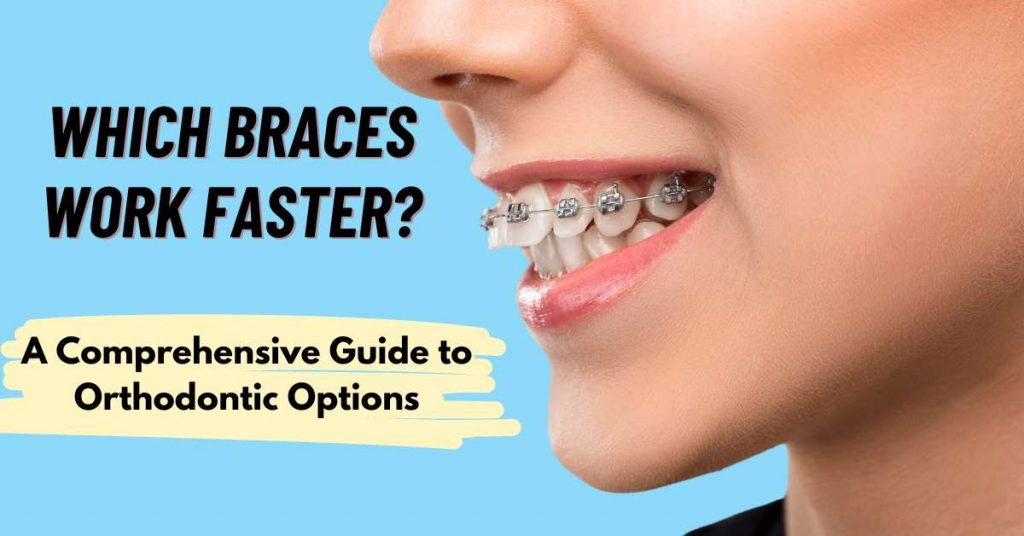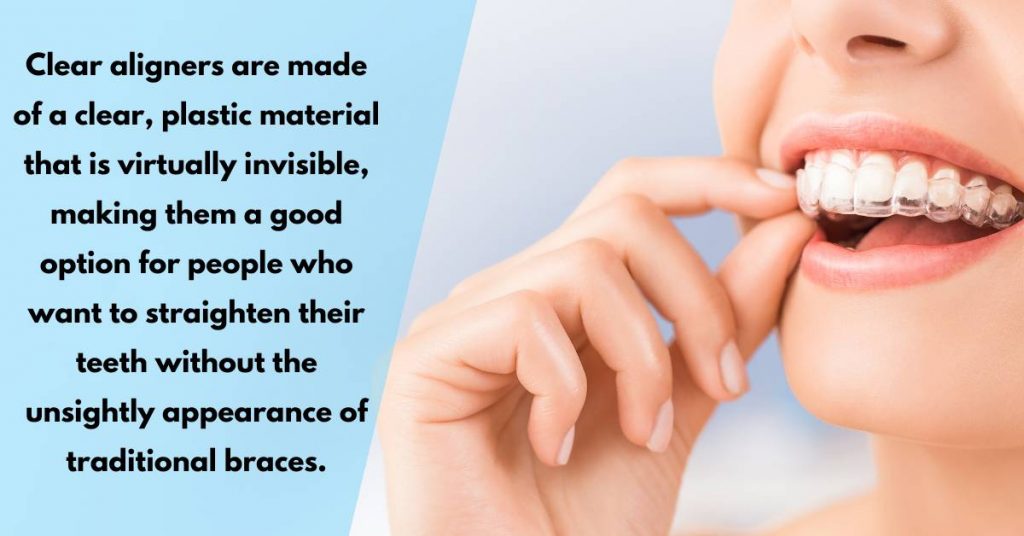Which Braces Work Faster? Exploring Orthodontic Treatment Speeds

Which Braces Work Faster? In general, clear aligners like Invisalign are considered to be faster than traditional braces with metal brackets and wires. This is because clear aligners are made of a flexible material that can be adjusted more easily than metal brackets. Additionally, clear aligners are removable, which allows patients to eat and drink more freely without worrying about damaging their braces.

However, it's crucial to remember that the malocclusion's severity also affects the speed of tooth movement. More severe malocclusions will require longer treatment times, regardless of the type of braces used.
Here is a table comparing the average treatment times for different types of braces:
| Type of Braces | Average Treatment Time |
| Traditional braces | 18-24 months |
| Clear aligners | 12-18 months |
| Self-ligating braces | 12-18 months |
| Lingual braces | 18-24 months |
Ultimately, the best way to determine which braces are right for you is to talk to your orthodontist. They can assess your needs and make recommendations based on your situation.
Here are some other factors to consider when choosing braces:
- Cost: Braces can vary depending on the type of braces, the severity of the malocclusion, and the orthodontist's fees.
- Appearance: Some prefer clear aligners because they are less noticeable than traditional braces.
- Comfort: Clear aligners are generally more comfortable than traditional braces, but this can vary from person to person.
- Maintenance: Clear aligners require more frequent changes than traditional braces.
It is important to weigh all of these factors when choosing braces. The best type of braces for you is the one that meets your individual needs and preferences.
The quest for a straighter smile has led to many orthodontic options, each promising effective results. One of the key considerations for many individuals is the speed at which braces can transform their teeth' alignment.
This comprehensive guide delves into orthodontics to answer the question: "Which braces work faster?" From traditional metal braces to innovative clear aligners, we'll explore various options and their effectiveness in achieving expedited orthodontic outcomes.
- Understanding Orthodontic Goals and Speed
- Types of Braces and Their Efficiency
- Traditional Metal Braces: Proven and Reliable
- Self-Ligating Braces: Efficiency with Modern Technology
- Clear Ceramic Braces: A Discreet and Effective Option
- Lingual Braces: Invisible Precision
- Fast Braces: Accelerated Orthodontic Treatment
- Invisalign and Clear Aligners: Innovations in Speed and Aesthetics
- Factors That Can Affect Treatment Speed
- Customizing Treatment for Individual Needs
- FAQs About Orthodontic Treatment Speed
- Q: Can I choose braces based solely on treatment speed?
- Q: Do all fast braces deliver results equally quickly?
- Q: How can I ensure my treatment progresses as quickly as possible?
- Q: Can wearing braces longer than recommended speed up the process?
- Q: Are there age-related differences in treatment speed?
- Q: Are all types of braces equally fast?
- Q: Can I choose braces based solely on speed?
- Q: Can patient compliance affect treatment speed?
- Q: Is accelerated orthodontics suitable for everyone?
- Conclusion: Finding the Right Balance Between Speed and Results
Understanding Orthodontic Goals and Speed
Factors Influencing Braces' Speed
Various factors influence the speed at which braces work to align teeth. Orthodontists consider each patient's unique dental anatomy, the case's complexity, and the type of braces chosen. While some orthodontic options are designed to expedite treatment, others prioritize precision and long-term results.
Types of Braces and Their Efficiency
Traditional Metal Braces: Proven and Reliable
Traditional metal braces have been a staple in orthodontics for decades. These braces are known for their effectiveness in treating various alignment issues. While not the fastest option available, they offer consistent and reliable results for patients of all ages.
Self-Ligating Braces: Efficiency with Modern Technology
Self-ligating braces feature brackets that use built-in clips to hold the archwire in place, reducing friction and allowing for smoother movement. This design can contribute to faster treatment times and fewer adjustments.
Clear Ceramic Braces: A Discreet and Effective Option
Clear ceramic braces provide a discreet alternative to metal braces. While not the fastest option, their aesthetic appeal makes them popular among individuals seeking a less noticeable treatment.
Lingual Braces: Invisible Precision
Lingual braces are attached to the back of the teeth, making them virtually invisible. While treatment times may vary, their hidden placement offers a discreet option for those seeking effective treatment without the appearance of braces.
Fast Braces: Accelerated Orthodontic Treatment
Fast braces, as the name suggests, focus on expediting treatment times. These braces employ innovative designs to move teeth more efficiently, reducing the overall duration of orthodontic treatment.
Invisalign and Clear Aligners: Innovations in Speed and Aesthetics
Invisalign and other clear aligner systems offer a modern approach to orthodontic treatment. While unsuitable for all cases, they can achieve faster results in mild to moderate misalignment cases.
Factors That Can Affect Treatment Speed
Individual Dental Anatomy and Complexity
Each person's dental anatomy is unique, and the case's complexity can influence treatment speed. Orthodontists carefully evaluate the alignment and determine the most suitable treatment approach.
Patient Compliance and Follow-Up
Patient compliance plays a crucial role in achieving timely results. Adhering to recommended wear times, maintaining oral hygiene, and attending scheduled appointments contribute to treatment efficiency.
Orthodontic Maintenance and Adjustments
Regular orthodontic maintenance and adjustments ensure that treatment progresses as planned. Orthodontists monitor progress and make necessary modifications to ensure optimal results.
Customizing Treatment for Individual Needs
The Role of Patient Compliance
Patient compliance is a crucial factor in achieving optimal treatment speed. Following orthodontists' recommendations, wearing appliances as instructed, and attending regular appointments contribute to effective and timely results.
Orthodontist Insights: Which Braces Work Faster?
Orthodontists emphasize that treatment speed varies from patient to patient. Factors like age, oral health, and the complexity of the case all play a role in determining the ideal treatment plan. Orthodontists consider the desired outcome and the patient's circumstances to recommend the most suitable braces.
FAQs About Orthodontic Treatment Speed
Q: Can I choose braces based solely on treatment speed?
A: While speed is a consideration, other factors, such as orthodontic needs and aesthetics, should also be weighed.
Q: Do all fast braces deliver results equally quickly?
A: The effectiveness of fast braces varies, and individual responses can influence treatment duration.
Q: How can I ensure my treatment progresses as quickly as possible?
A: Following your orthodontist's instructions, attending appointments, and maintaining oral hygiene is key.
Q: Can wearing braces longer than recommended speed up the process?
A: Orthodontic treatment should always follow a professional's recommendations for the best results.
A: Treatment speed can vary based on age, as younger individuals often have more adaptable bone structures.
Q: Are all types of braces equally fast?
A: No, treatment speeds vary depending on the type of braces and individual factors.
Q: Can I choose braces based solely on speed?
A: We should consider treatment needs and aesthetics in addition to speed.
Q: Can patient compliance affect treatment speed?
A: Yes, following orthodontist instructions and attending appointments play a role in achieving timely results.
Q: Is accelerated orthodontics suitable for everyone?
A: Not all patients are candidates for accelerated techniques. Orthodontists assess eligibility based on individual cases.
Conclusion: Finding the Right Balance Between Speed and Results
In orthodontics, no one-size-fits-all answer to the question, "Which braces work faster?" The answer depends on many factors, from the type of braces to individual patient needs and compliance. Balancing speed with effective results is the ultimate goal, ensuring patients achieve both the smile they desire and the oral health they deserve.

Recommendation